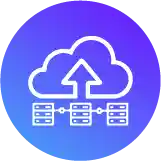Cloud Computing
In today's technology-driven world, cloud computing stands as a pillar of innovation, enabling individuals and businesses to tap into an expansive ecosystem of services and resources. In this comprehensive guide, we will embark on a journey through the realm of cloud computing, exploring ten key facets that define its impact on our digital landscape.
1. How to Use Cloud Computing for Machine Learning and AI:
Cloud computing has become the bedrock for accelerating the adoption of machine learning and artificial intelligence. The synergy between cloud platforms like AWS, Azure, and Google Cloud and AI/ML technologies is reshaping industries. By providing access to virtually unlimited computing power and storage, the cloud has democratized AI and ML. Whether you're training complex deep learning models or deploying AI applications, the cloud offers scalability and cost-efficiency like never before.
2. Use Cloud Computing to Build and Deploy Serverless Applications:
Serverless computing, often referred to as Functions as a Service (FaaS), is revolutionizing the way applications are developed and deployed. The cloud is the natural home for serverless architecture. AWS Lambda, Azure Functions, and other serverless platforms enable developers to focus solely on code, abstracting away infrastructure management. This shift in perspective streamlines development and reduces operational overhead, making it a compelling choice for businesses aiming to create scalable and efficient applications.
3. Hybrid Cloud vs. Multi-Cloud: Which Is Right for Your Business?
One of the critical decisions for businesses is selecting the most suitable cloud strategy. Hybrid cloud, which combines on-premises infrastructure with public and private clouds, and multi-cloud, which leverages services from multiple cloud providers, are two prevailing approaches. The choice between them depends on a range of factors, including regulatory compliance, data residency, and application requirements. Understanding the nuances of each approach is vital in aligning your cloud strategy with your specific business goals and needs.
4. The Economics of Cloud Computing: Cost Optimization Strategies:
Cost efficiency is paramount in any business endeavor, and cloud computing is no exception. In this section, we'll delve into the financial aspect of cloud adoption. The cloud's "pay-as-you-go" model offers flexibility, but it can lead to cost overruns if not managed effectively. We'll explore strategies for cost optimization, which include rightsizing resources, implementing monitoring and automation, and choosing appropriate pricing models. By mastering these strategies, businesses can make the most of their cloud investments.
5. Cloud Computing Trends to Watch in 2023:
The cloud computing landscape is in perpetual motion, with new trends and technologies emerging regularly. As we gaze into the near future, we anticipate several trends that will have a profound impact on the industry in 2023. These include edge computing, a paradigm that moves computing resources closer to data sources and users, enhancing latency-sensitive applications. The rise of containerization and Kubernetes adoption will continue to empower application development and deployment. Moreover, the infusion of artificial intelligence and machine learning into cloud services will further optimize performance, security, and resource allocation.
6. The Future of Cloud Computing: Predictions and Innovations:
Predicting the future of cloud computing is a speculative yet fascinating endeavor. The trajectory of cloud technology is poised for remarkable innovations in the coming years. Quantum computing, with its potential to revolutionize computation, is a field to watch. As quantum hardware matures, it may become an integral part of cloud services, addressing complex problems at speeds unimaginable with classical computing. Additionally, the growth of serverless computing, further reducing operational overhead, and the influence of evolving regulations and data privacy laws will shape the landscape. To prepare for these changes, businesses must stay agile and adaptable.
7. Cloud-Native Security: Protecting Applications in a Cloud Environment:
Security is a paramount concern in the cloud, where applications and data are exposed to a dynamic, ever-changing environment. Protecting cloud-native applications requires a different approach than traditional on-premises security. In this section, we will delve into the nuances of cloud-native security, including identity and access management, encryption, and compliance requirements. We'll explore how to mitigate threats and vulnerabilities specific to the cloud, such as data breaches, misconfigured security settings, and distributed denial-of-service (DDoS) attacks. Staying ahead of these security challenges is essential for businesses aiming to safeguard their digital assets and maintain the trust of their customers.
8. The Role of Cloud Computing in Digital Transformation:
Digital transformation is a strategic imperative for businesses aiming to stay competitive in a rapidly evolving landscape. Cloud computing serves as a linchpin in this transformation journey. It empowers organizations to adapt, innovate, and deliver value to their customers by providing scalable infrastructure, streamlined operations, and access to a rich ecosystem of services. As we explore the role of cloud computing in digital transformation, we will discuss real-world examples and case studies that highlight how businesses have harnessed the power of the cloud to drive innovation and redefine their market presence.
9. Data Management in the Cloud: Best Practices and Tools:
Effective data management is central to leveraging the full potential of the cloud. The cloud offers a plethora of tools and services for data storage, processing, and analytics. We will explore best practices and the ecosystem of data management tools available. Topics will encompass cloud-native data storage services such as AWS S3, Azure Blob Storage, and Google Cloud Storage, as well as data processing and analytics solutions like AWS Glue, Google BigQuery, and Azure Data Lake. In today's data-driven world, understanding these tools and practices is vital for businesses looking to gain insights from their data and make informed decisions.
10. How to Use Cloud Computing for Big Data Analytics:
Big data analytics has become a linchpin in the decision-making process for businesses across industries. The massive volumes of data generated daily necessitate scalable and flexible computing resources, and cloud computing meets this need impeccably. In this section, we will guide you through the process of using cloud computing to supercharge your big data analytics initiatives. We'll discuss how cloud platforms provide the necessary infrastructure and services for processing, storing, and analyzing vast datasets, and how this can empower data-driven decision-making without the complexities of managing on-premises infrastructure. We'll explore real-world use cases and best practices, ensuring that you are well-prepared to extract valuable insights from your data.
Conclusion
In conclusion, cloud computing is a transformative force that has reshaped the digital landscape, providing unparalleled opportunities for innovation and efficiency. Each of the sub-topics discussed here illustrates a distinct facet of cloud computing's power and versatility. By understanding these nuances and staying informed about trends, businesses and individuals can harness the full potential of the cloud, positioning themselves as pioneers in the ever-evolving world of technology. Embracing the cloud's capabilities will undoubtedly open doors to endless possibilities and greater success in your digital endeavors.











